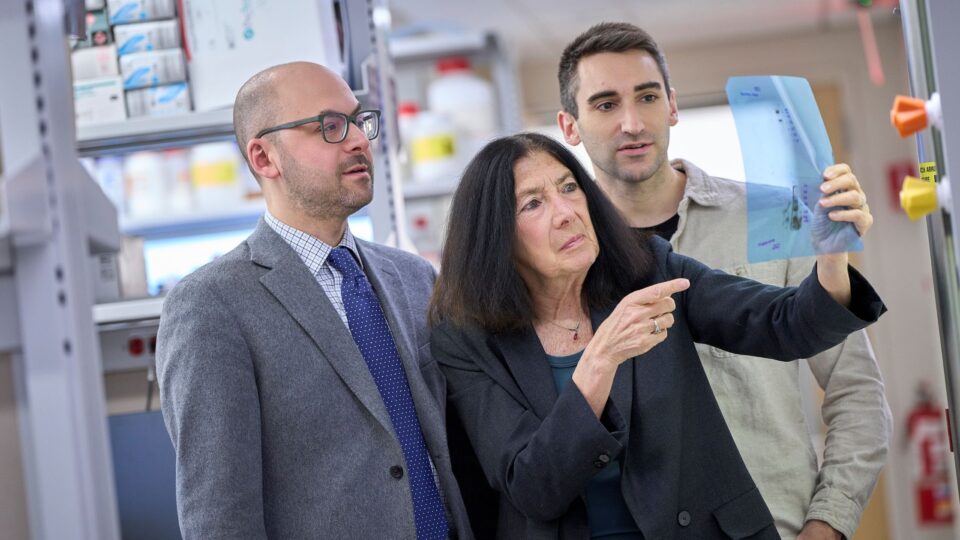To aid the search for better therapeutics for autoimmune and inflammatory diseases, a 2014 NIH-sponsored effort called the Accelerating Medicines Partnership, or AMP, first focused on understanding the cellular and molecular pathways of rheumatoid arthritis and lupus. Under a new program launched in December 2021, an initiative called AMP Autoimmune and Immune-Mediated Diseases, or AMP AIM, has expanded to include psoriatic disease and Sjögren’s syndrome as additional areas of focus.
NYU Langone Health is a lead center in the ambitious effort, which has attracted $58 million overall in public and private funding over five years. The partnership is pairing rheumatologists and dermatologists from NYU Langone and several other academic centers with the NIH, the Food and Drug Administration, pharmaceutical companies, and nonprofit organizations.
Jill P. Buyon, MD, the Sir Deryck and Lady Va Maughan Professor of Rheumatology in the Department of Medicine, will serve as contact principal investigator of the AMP AIM program’s lupus team. Jose U. Scher, MD, the Steere-Abramson Associate Professor of Medicine, will lead the program’s microbiome core and serve as co-principal investigator of a psoriatic disease clinical team, and Peter M. Izmirly, MD, associate professor of medicine, will oversee a clinical site for the Sjögren’s syndrome team.
“As the pace of discovery in the biology, genetics, and environmental regulation of SLE [systemic lupus erythematosus] accelerates, the speed and efficiency of translationally applying that research to clinical care assumes even greater importance.”
Jill P. Buyon, MD
An Acceleration of Discoveries in Lupus Research
NYU Langone’s Division of Rheumatology led one of the lupus disease teams for the earlier AMP program that paved the way for the now-expanded effort. The team’s focus on lupus nephritis, aided by an enrollment of more than 150 patients at NYU Langone who contributed kidney tissue for research, helped establish new protocols for tissue preservation and dissociation.
From resident kidney cells and 21 clusters of immune cells, the team’s single-cell transcriptomic data yielded multiple discoveries. Publications in Nature Immunology, for example, described evidence of local activation of B cells, and progressive stages of monocyte differentiation and tubular type I interferon and fibrotic signatures as predictors of poor responses to treatment.
“As the pace of discovery in the biology, genetics, and environmental regulation of SLE [systemic lupus erythematosus] accelerates, the speed and efficiency of translationally applying that research to clinical care assumes even greater importance,” Dr. Buyon says. “We now have an unprecedented opportunity to harness technological advances to deconstruct and reconstruct the enormity of phenotypic and immunologic heterogeneity in this prototypic autoimmune disease.”
Within the new AMP AIM progam, the group lead by Dr. Byron—the Lupus Omics Cutaneous Kidney Investigation Team (LOCKIT)—is a partnership with Johns Hopkins University, The Ohio State University, and the University of Pennsylvania. The institutions’ well-established patient registries, Dr. Buyon says, will help the team illuminate the molecular underpinnings of early kidney disease and cutanous disease with the hope of bringing new therapies to patients.
Probing the Microbiome and Skin for Clues
The AMP AIM program’s microbiome core, or Micro-TeACH (Microbiome Technology and Analytic Center Hub), led by Dr. Scher, will incorporate intestinal, skin, and other tissue-related microbiome features to aid in the pathogenesis reconstruction for various autoimmune and immune mediated diseases.
The hub will help researchers interrogate the gut microbiome and its potential metabolic capacity to modulate anti-rheumatic drugs’ pharmacokinetics and response to therapy. In addition, the tools will enable an integration of the cutaneous and oral microbiome with tissue-derived spatial transcriptomics and single-cell technologies.
The psoriatic disease team Dr. Scher is also co-leading has been dubbed ELLIPSS, or ELucidating the Landscape of Immunoendotypes in Psoriatic Skin and Synovium. Participants in varying stages of psoriatic disease will undergo biopsies of the skin and joint synovium to better identify the distinct functional or pathobiological mechanisms.
“The skin may have the code for who progresses, why, and how,” Dr. Scher says. “We want to find which cells that reside in the skin are being attracted—the term we use is homing—to the joints and produce and promote inflammation there.”
“What’s in that code may help us adopt a desperately needed precision medicine approach.”
Jose U. Scher, MD
Any patterns and pathways, in turn, could have major implications for therapeutics. “What’s in that code may help us adopt a desperately needed precision medicine approach,” Dr. Scher says.







